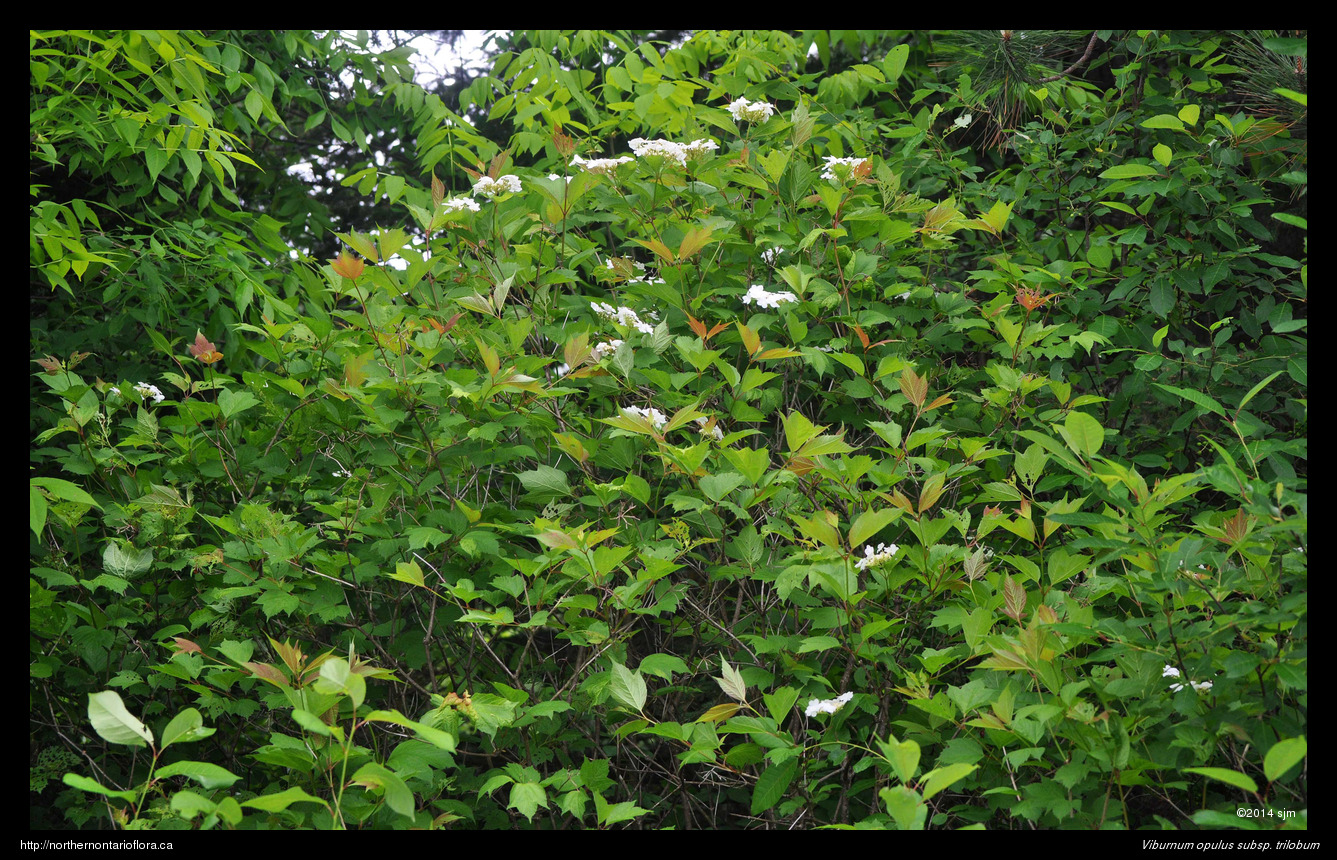
|
Northern Ontario Plant Database 
Plant DescriptionViburnum trilobum MarshallEn: highbush cranberry, American bush cranberry, cranberry-tree, grouseberry, crampbark
Adoxaceae (Viburnum Family) Synonyms: Viburnum trilobumMarshall, Viburnum opulus L. var. americanum Aiton Nomenclatural Notes: This shrub was previously known by the name Viburnum trilobum, but it is now considered to be a North American subspecies of Viburnum opulus L., the European guelder-rose. The European subspecies, V. opulus subsp. opulus L., varies little from our North American plants, thus many botanists believe the North American plants are classified as a subspecies (subsp. trilobum) or variety (var. americanum) of Viburnum opulus. The snowball bush, a showy form of the European subspecies (cultivar 'Roseum'), is often planted in gardens, but is not naturalized in Canada. In this form, all of the flowers have large corollas and are sterile, so produce no fruit. General: A tall deciduous shrub, to about 4 m high, with maple-like leaves and beautiful showy white flowers. Stems/twigs: Twigs are smooth (glabrous), with greyish bark. Lateral bud are opposite and have 2 hard reddish-brown valvate bud scales. Terminal buds are absent, with twigs often ending in a long thin stalk (the remains of the old flowering stalk). New shoots arise from lateral buds at the base of old flowering stalks, while flower buds occur at the end of lateral branches. Leaves: Opposite, simple, palmately-veined and 3-lobed. The grooved petioles, 1—4 cm long, bear a pair of domed to club-shaped (clavate) glands near the leaf blade, while a pair of long thin stipules with thickened tips is attached near the petiole base. Leaf blades are 5—11 cm long and wide, glabrous, and dark green above. Mature leaf blades are ovate to broadly ovate, divided into 3 lobes above, with one major vein extending into each of the 3 lobes; bases are rounded to flat (truncate) and margins are coarsely toothed. Newly emerging terminal leaf pairs have 3 long-pointed (acuminate) lobes, bases are tapering (cuneate) to nearly rounded, and margins are entire to slightly blunt-toothed. Flowers: Bisexual, white, arranged in large flat-topped terminal inflorescences (cymes), 4—15 cm across. Marginal flowers of the inflorescence are sterile, with enlarged flat white 5-lobed corollas; the numerous fertile central flowers are small, and each has an inconspicuous calyx, a short-tubular creamy-white 5-lobed corolla, 5 stamens that are adnate to and extend beyond the corolla (exserted), and a single inferior ovary. Flowers bloom in mid summer. Fruit: Clusters of ellipsoid to globose, reddish-orange to red, berry-like drupes, 6—12 mm long, each with a single flat seed inside a stony pit. Fruits ripen in late summer, but persist on the shrub overwinter, becoming transluscent red, wrinkled, and occuring in pendant clusters. The edible, juicy, but tart fruit may be used to make jam. Like squashberry, the ripe fruits of highbush cranberry have a strong musky odour that persists through cooking, but the smell is absent in the resulting jams and jellies. Habitat and Range: Along streambanks, shorelines, and along the margins of damp woods, swamps, and peatlands. The highbush cranberry (subsp. trilobum) is native to boreal North America. In Ontario, its range extends throughout the Algoma District and across forested regions of Ontario, occurring north to James Bay and Lake-of-the-Woods, to about 52° N (Soper & Heimburger 1982). Similar Species: Around the Wawa area and northward, the mature leaves of highbush cranberry may be confused with the leaves of squashberry (Viburnum edule (Michx.) Raf.), but the latter shrub is much shorter (less than 2 metres tall), has leaves with more sharply-toothed margins, and has fewer-flowered inflorescences that are terminal on lateral shoots, with small flowers of one size. Also, newly emerged terminal pairs of leaves in squashberry are unlobed, but become 3-lobed as the leaves mature and new leaf pairs develop at the branch tips. Highbush cranberry, the common name for Viburnum opulus subsp. trilobum in eastern and central Canada, is sometimes applied to Viburnum edule in western Canada, particularly in B.C. Highbush cranberry leaves are also somewhat similar in general appearance to the leaves of maples (Acer spp.) and currants (Ribes spp.), both of which have 3—5-lobed leaves. Back to species list |
||||||||||||||||||||||

























